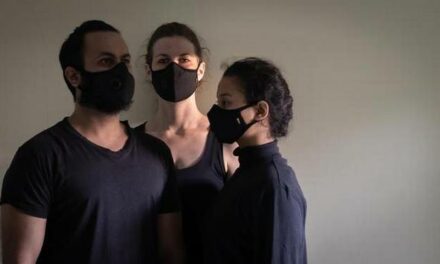Believe me when I tell you that there is much more to Alice Birch’s play [BLANK] than meets the eye. This is not only because Maria Aberg’s production at the Donmar Warehouse selects and reorders 22 scenes out of the 100 in Birch’s script, but because it fills in the “blanks” of the text (characters’ names, genders, ages) in ways that construct certain narratives and eschew a great many others—all of which are dormant in the play as it lives on the page.
In her note to the script, Birch calls her method “a challenge and an invitation” for each producing team to make their own play. It is useful to remember that Caryl Churchill’s Love and Information (2012) had a similar premise, though Birch’s approach is admittedly more flexible, barely prescribing any rules. Hence, Aberg’s all-female staging of this work creates a distinct play of its own—one that centers Birch’s scenes on the precarity of vulnerable, abused, and neglected women. [BLANK] was originally co-commissioned by the National Theatre and Clean Break, a leading theatre company working with women affected by the criminal justice system; so it is no wonder that the Donmar production, also co-produced by Clean Break, attempts to ground this self-consciously malleable play around this guiding concern.
Mothers and daughters, sisters and friends, prisoners and guards are the characters that populate Aberg’s take on the work. The 22 scenes vary widely in their setting, tone, and style, but common to many of them are shadowy references to abusive men, rejected pleas for help from other women, and attempts to escape oppressive realities. Birch’s (and Aberg’s) women are variously suffocated by the curveballs thrown at them—from family, friends, or the state—but they are also brave enough to ask for help, to reach outward, even though all these efforts prove tragically fruitless.
Rosie Elnile’s design places these numerous narratives on a two-storied set that resembles an abstracted, stripped-down cross-section of a house. The dominant colors of this scenography are sterile shades of blue and green, of the sort one would encounter in a depressing hospital. Jess Bernberg’s brusque lighting (aided by fluorescent lights) and Carolyn Downing’s ominously rhythmic sound design further turn this environment into a minefield of anxieties on the brink of combustion.
Crucially, this is a minefield where explosions are often subdued but still devastating. A versatile and exceedingly strong cast of 14 embodies these diverse scenes with equal measures of variance and consistency. Those few actors whose characters recur in multiple scenes are especially good at giving us a convincing sense of the passage of time and change of circumstance. Every now and then, a deadpan style casts its unexpected shadow on some of the performances, but even then the ultimate effect turns out to be emotionally crippling. One can easily tell that every one of these actors has positively wrestled with Birch’s charged, sly language.

The cast of [BLANK] at the Donmar Warehouse. Photo: Helen Maybanks
Perhaps most troublingly, Aberg has decided to have a handful of characters recur in multiple scenes, while the actors playing those characters still appear in other scenes as other characters. Accordingly, the start of a new scene often triggers a sense of uncertainty about the nature of its relation to the whole: is this the continuation of something from before, or is it entirely new? Asking this question—and looking for an answer—does not make for the best use of one’s time, and the production would have done well to establish clearer, more reliable rules of engagement for both structure and style.
Despite these inconsistencies, Aberg’s [BLANK] still boasts plenty of excellent moments. Chief among these are three spellbinding scenes: “Carrier Bags” is between two foster children (Zaris-Angel Hator and Taya Tower, both brilliant), one of whom militantly divides up their room to keep their stuff separate. “Transference” depicts a mother (an enchantingly restrained Thusitha Jayasundera) who receives the news of her daughter’s prison suicide from a nervous social worker (Jemima Rooper). And finally, a magnificent, 45-minute “Dinner Party” scene—which is dazzling enough to be a play of its own—features the whole cast in its relentlessly acerbic takedown of liberal hypocrisy.
The titular party brings together a large group of female friends whose self-indulgent fictions of progress and empathy (about the #MeToo movement, among other issues) are shockingly exposed—and exploded—by a newcomer. Aberg’s meticulous direction, including her haunting transition to the gnomic “Smash” scene, and the company’s scalpel-sharp performances make this the obvious highlight of the evening, so much so that one can’t fault the scene’s considerable incongruence with the play proper. If only Aberg had concluded the production with this masterful centerpiece… (The two surprisingly bland scenes that follow upon it could easily be jettisoned.) It is worth seeing [BLANK] even if only for this nested tour de force of theatrical imagination.
It bears noting, therefore, that Alice Birch’s Churchillian experiments with form and language—which were also evident in Revolt. She Said. Revolt Again. (2016) and Anatomy of a Suicide (2017)—are an invaluable gift to theatre. In [BLANK], her engrossing engagement with the semantics and ethics of intimacy and hostility, of privacy and collectivity, secures her name as one the most exciting voices of her generation. And for all its occasional pitfalls, Maria Aberg’s production succeeds as an ambitious, handsome version of this endlessly playful play. At its best, it leaves one at once stunned and wide-awake.
This post was written by the author in their personal capacity.The opinions expressed in this article are the author’s own and do not reflect the view of The Theatre Times, their staff or collaborators.
This post was written by Mert Dilek.
The views expressed here belong to the author and do not necessarily reflect our views and opinions.

![Alice Birch’s “[BLANK]” at the Donmar Warehouse](https://thetheatretimes.com/wp-content/uploads/2019/10/image-3-1280x640.jpg)
















